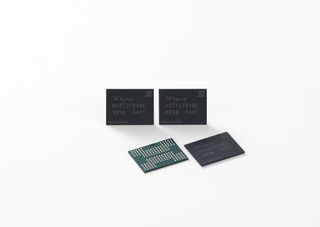SK hynix announces production of its 321-layer NAND flash — shipments will start in the first half of 2025
SK hynix finally announces production of the world's highest-layer NAND flash to date.

SK hynix has announced the mass production of the world's first 321-layer NAND flash. According to the press release, the company will supply customers with its 321-high NAND flash featuring 1TB capacity starting in 1H 2025.
SK hynix's 321-layer high NAND flash is built on a technology the company dubs the "3 plugs" process. This technology is purportedly known for its excellent production efficiency, and "...electrically connects three plugs through an optimized follow-up process after three times of plug processes are finished." "For the process, SK hynix developed a low-stress material while introducing the technology that automatically corrects alignments among the plugs."
SK hynix also uses the same development platform for its 321-layer NAND as its previous generation 238-layer flash, yielding a purported 59% improvement in 321-layer production. The move to 321 layers has purported improved data transfer speeds by 12% and read performance by 13% compared to the previous generation. Power efficiency has also been increased by more than 10%.
| Row 0 - Cell 0 | SK hynix | Samsung | Micron | YMTC | Kioxia |
| Current Layer Count | 321-layers | 280-layers | 232-layers | 232-layers | 218-layers |
321-layer NAND flash is currently the highest-layer flash in the industry. Samsung is the closest so far, with its 280-layer NAND flash, but it is actively working on 300-layer and even 400-layer flash to compete with SK hynix. Micron, YMTC, and Kioxia are the furthest behind, with 232-layer and 218-layer architectures at the time of writing.
Samsung's next-generation 300-layer NAND flash will purportedly be produced differently from SK hynix. It will use a "double-stack" technique, which involves placing one 3D NAND stack on a 300 mm wafer and building another stack of flash on top of the first one. SK hynix's solution is purportedly more efficient and involves using three layers.
Stay On the Cutting Edge: Get the Tom's Hardware Newsletter
Get Tom's Hardware's best news and in-depth reviews, straight to your inbox.

Aaron Klotz is a contributing writer for Tom’s Hardware, covering news related to computer hardware such as CPUs, and graphics cards.
-
Mama Changa 1TB in possibly 6-9 months, whoopty doo. No one literally gives a toss about 1TB now, that is the new 256GB. If it's not releasing in 4TB at least then zero effs given how mahy layers it's got unless random performance finally gets close to Optane.Reply -
usertests Reply
The article is incorrect. It's actually 1/8th of that, 1 Tb:Mama Changa said:1TB in possibly 6-9 months, whoopty doo. No one literally gives a toss about 1TB now, that is the new 256GB. If it's not releasing in 4TB at least then zero effs given how mahy layers it's got unless random performance finally gets close to Optane.
the company will supply customers with its 321-high NAND flash featuring 1TB capacity starting in 1H 2025.
SK hynix Inc. announced today that it has started mass production of the world’s first triple level cell-based 321-high 4D NAND Flash with 1Tb capacity.
1 Tb NAND dies get stacked into larger packages, such as 1 TB. They might be able to stack 16 of them to make a 2 TB package.
While 1 Tb is not an interesting number, the new 321-layer die is likely to be smaller and cheaper than what it replaced. Unless you need a small flash drive with only one package, your SSD is probably going to get more than one package. We are probably close to 16 TB M.2 2280 being viable for consumers, but the cost is a bigger issue than density.
One of the more interesting things from this older press release is Multi-Site Cell (MSC). They are claiming they can make HLC (6 bits-per-cell) with the performance and characteristics of TLC (3 bits-per-cell). Big if true:
https://news.skhynix.com/how-sk-hynixs-advanced-4d-nand-technologies-are-overcoming-stacking-limitations/ -
DavidLejdar May not sound much for casual desktop users these days. In terms of i.e. smartphones though, with still somewhat increasing resolutions of photos/ videos (meaning increased file sizes, due to more pixels), it is quite a thing.Reply
And the market is not small, with more than one billion smartphones having been shipped and sold yearly for years, talking around half a trillion revenue. So, a lot of supply needs there, with quality demands.
Most Popular








